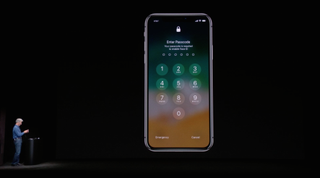Watch iPhone X Face ID get stage fright at its Apple event debut
But Apple says 'Face ID worked as it was designed to'

Update: Apple has commented on the situation, revealing that Face ID apparently worked as designed, but that Federighi was simply locked out of it due to other people handling the iPhone X ahead of time. Full details are below.
Just how reliable will Face ID be, the new facial recognition system built into Apple's new iPhone X handset? It may need a bit of fine tuning, if its debut at Tuesday's big Apple event was anything to go by, and though Apple has since commented on the situation, it doesn't alleviate all our concerns.
Being demoed onstage by Craig Federighi, Apple's senior vice president of Software Engineering, Face ID seemed to have trouble recognising the executive in order to unlock the iPhone X.
You can see the shaky moment in action at the re-run page for the event's livestream. It kicks in at just after the 1 hour, 35 minute and 30 seconds point.
New tech, new creases to iron?
The Face ID system uses the iPhone X's TrueDepth camera in order to ensure only the correct user gets access to the phone's innards. And it's a multi-tiered system that should let it work seamlessly and safely, according to Apple.
A dot projector is used to build an accurate map of the shape of your face in 3D, with 30,000 invisible dots pinpointing the curves of your head and features. An infrared camera then reads that pattern and captures an infrared image, using the two data sets to confirm a match on the software side. There's also a Flood Illuminator that uses infrared light to help identify users in the dark.
Was one of these elements struggling on stage? While the Face ID system did eventually pick up Federighi's features (after a second attempt), it wasn't the perfect demonstration Apple would have hoped for. And, according to our man on the ground Gareth Beavis in his hands on: iPhone X review, it was problematic at the post-event demo area too.
Get daily insight, inspiration and deals in your inbox
Get the hottest deals available in your inbox plus news, reviews, opinion, analysis and more from the TechRadar team.
Apple's take
Yahoo has since got in touch with an Apple rep who explained that "people were handling the device for stage demo ahead of time and didn’t realize Face ID was trying to authenticate their face.
"After failing a number of times, because they weren’t Craig, the iPhone did what it was designed to do, which was to require his passcode.” In other words, “Face ID worked as it was designed to."
Facial recognition has had a bad rap in security circles previously, having been easy to hack, while the removal of Touch ID in the iPhone X makes Face ID's accuracy of the upmost importance.
And given TechRadar's own hands on experience with Face ID, it may not be fully polished even if it didn't fail on stage. But with the iPhone X shipping to customers this November, Apple has a few weeks yet to fine-tune the system.
There's a very good chance that this is far from final software at this early stage, meaning Apple could have perfected the system by the time it reaches consumers.
Security in an increasingly-connected world is a growing concern, even among the casual tech fan and, in many ways Apple has set elevated standards for itself by developing the ever-reliable Touch ID fingerprint scanner. Here's hoping it irons out the Face ID creases, so that it can identify the ones in our furrowed brows.
Gerald is Editor-in-Chief of iMore.com. Previously he was the Executive Editor for TechRadar, taking care of the site's home cinema, gaming, smart home, entertainment and audio output. He loves gaming, but don't expect him to play with you unless your console is hooked up to a 4K HDR screen and a 7.1 surround system. Before TechRadar, Gerald was Editor of Gizmodo UK. He is also the author of 'Get Technology: Upgrade Your Future', published by Aurum Press.

